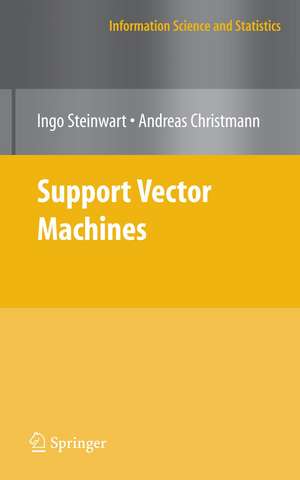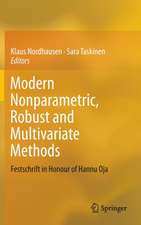Support Vector Machines: Information Science and Statistics
Autor Ingo Steinwart, Andreas Christmannen Limba Engleză Paperback – 31 oct 2014
| Toate formatele și edițiile | Preț | Express |
|---|---|---|
| Paperback (1) | 1059.92 lei 6-8 săpt. | |
| Springer – 31 oct 2014 | 1059.92 lei 6-8 săpt. | |
| Hardback (1) | 1462.66 lei 6-8 săpt. | |
| Springer – 12 aug 2008 | 1462.66 lei 6-8 săpt. |
Din seria Information Science and Statistics
- 24%
 Preț: 1151.34 lei
Preț: 1151.34 lei - 24%
 Preț: 1327.63 lei
Preț: 1327.63 lei - 20%
 Preț: 415.71 lei
Preț: 415.71 lei - 18%
 Preț: 1384.56 lei
Preț: 1384.56 lei - 18%
 Preț: 1114.83 lei
Preț: 1114.83 lei - 18%
 Preț: 1125.09 lei
Preț: 1125.09 lei - 15%
 Preț: 647.73 lei
Preț: 647.73 lei - 20%
 Preț: 1050.02 lei
Preț: 1050.02 lei - 18%
 Preț: 956.03 lei
Preț: 956.03 lei - 20%
 Preț: 650.27 lei
Preț: 650.27 lei - 18%
 Preț: 897.65 lei
Preț: 897.65 lei - 15%
 Preț: 583.56 lei
Preț: 583.56 lei - 15%
 Preț: 591.79 lei
Preț: 591.79 lei -
 Preț: 386.61 lei
Preț: 386.61 lei - 20%
 Preț: 1284.14 lei
Preț: 1284.14 lei -
 Preț: 394.51 lei
Preț: 394.51 lei - 20%
 Preț: 989.31 lei
Preț: 989.31 lei - 18%
 Preț: 953.03 lei
Preț: 953.03 lei - 20%
 Preț: 335.52 lei
Preț: 335.52 lei - 18%
 Preț: 891.02 lei
Preț: 891.02 lei
Preț: 1059.92 lei
Preț vechi: 1324.90 lei
-20% Nou
Puncte Express: 1590
Preț estimativ în valută:
202.84€ • 220.25$ • 170.39£
202.84€ • 220.25$ • 170.39£
Carte tipărită la comandă
Livrare economică 22 aprilie-06 mai
Preluare comenzi: 021 569.72.76
Specificații
ISBN-13: 9781489989635
ISBN-10: 1489989633
Pagini: 620
Ilustrații: XVI, 603 p.
Dimensiuni: 155 x 235 x 33 mm
Greutate: 0.86 kg
Ediția:2008
Editura: Springer
Colecția Springer
Seria Information Science and Statistics
Locul publicării:New York, NY, United States
ISBN-10: 1489989633
Pagini: 620
Ilustrații: XVI, 603 p.
Dimensiuni: 155 x 235 x 33 mm
Greutate: 0.86 kg
Ediția:2008
Editura: Springer
Colecția Springer
Seria Information Science and Statistics
Locul publicării:New York, NY, United States
Public țintă
Professional/practitionerCuprins
Loss Functions and Their Risks.- Surrogate Loss Functions (*).- Kernels and Reproducing Kernel Hilbert Spaces.- Infinite-Sample Versions of Support VectorMachines.- Basic Statistical Analysis of SVMs.- Advanced Statistical Analysis of SVMs (*).- Support Vector Machines for Classification.- Support Vector Machines for Regression..- Robustness.- Computational Aspects.- Data Mining.
Recenzii
From the reviews:
“This book has many remarkable qualities which make it commendable to a large mathematical audience. …It is probably the first book on this topic…which is genuinely aimed at a mathematician reader. No technical issue is avoided, and fine points like measurability, integrability, existence and regularity of solutions, etc., are addressed with due rigor and precision. …The authors take special care to make the book self-contained and accessible to non-specialists…always including very detailed proofs for all results. A substantial appendix acts as a handy reference of fundamental results of analysis and probability needed throughout the book, even including a full proof of Talagrand’s concentration inequality. Many well-thought –out exercises very nicely complete each chapter. Finally, the book as a whole, though voluminous and presenting for the most part some very recent results, always stays very coherent to its choices and goals, and obviously a lot of effort has gone into a clear organization of the material. This work is bound to be recognized as a classic reference on this topic.” (MathSciNet)
“This book presents an extensive account of … Support Vector Machines (SVMs). … The book has many remarkable qualities which make it commendable to a large mathematical audience. First of all it is probably the first book on this topic … which is genuinely aimed at a mathematician reader. … Secondly, the authors take special care to make the book self contained and accessible to non-specialists … . Many well thought-out exercises very nicely complete each chapter. … a classic reference on this topic.” (Gilles Blanchard, Mathematical Reviews, Issue 2010 f)
“A mathematically elaborated topic of support vector machines in a book full with definitions and lemmas. It presents support vector machines (SVMs) as a successful modeling and prediction tool with different examples. This book has 12 chapters and 9 appendices that introduce also marginal applications of SVMs. … This book is … suitable as a textbook on SVMs for graduate courses … .” (Adriana Horníková, Technometrics, Vol. 53 (2), May, 2011)
“This book has many remarkable qualities which make it commendable to a large mathematical audience. …It is probably the first book on this topic…which is genuinely aimed at a mathematician reader. No technical issue is avoided, and fine points like measurability, integrability, existence and regularity of solutions, etc., are addressed with due rigor and precision. …The authors take special care to make the book self-contained and accessible to non-specialists…always including very detailed proofs for all results. A substantial appendix acts as a handy reference of fundamental results of analysis and probability needed throughout the book, even including a full proof of Talagrand’s concentration inequality. Many well-thought –out exercises very nicely complete each chapter. Finally, the book as a whole, though voluminous and presenting for the most part some very recent results, always stays very coherent to its choices and goals, and obviously a lot of effort has gone into a clear organization of the material. This work is bound to be recognized as a classic reference on this topic.” (MathSciNet)
“This book presents an extensive account of … Support Vector Machines (SVMs). … The book has many remarkable qualities which make it commendable to a large mathematical audience. First of all it is probably the first book on this topic … which is genuinely aimed at a mathematician reader. … Secondly, the authors take special care to make the book self contained and accessible to non-specialists … . Many well thought-out exercises very nicely complete each chapter. … a classic reference on this topic.” (Gilles Blanchard, Mathematical Reviews, Issue 2010 f)
“A mathematically elaborated topic of support vector machines in a book full with definitions and lemmas. It presents support vector machines (SVMs) as a successful modeling and prediction tool with different examples. This book has 12 chapters and 9 appendices that introduce also marginal applications of SVMs. … This book is … suitable as a textbook on SVMs for graduate courses … .” (Adriana Horníková, Technometrics, Vol. 53 (2), May, 2011)
Notă biografică
Ingo Steinwart is a researcher in the machine learning group at the Los Alamos National Laboratory. He works on support vector machines and related methods.
Andreas Christmann is Professor of Stochastics in the Department of Mathematics at the University of Bayreuth. He works in particular on support vector machines and robust statistics.
Andreas Christmann is Professor of Stochastics in the Department of Mathematics at the University of Bayreuth. He works in particular on support vector machines and robust statistics.
Textul de pe ultima copertă
This book explains the principles that make support vector machines (SVMs) a successful modelling and prediction tool for a variety of applications. The authors present the basic ideas of SVMs together with the latest developments and current research questions in a unified style. They identify three reasons for the success of SVMs: their ability to learn well with only a very small number of free parameters, their robustness against several types of model violations and outliers, and their computational efficiency compared to several other methods.
Since their appearance in the early nineties, support vector machines and related kernel-based methods have been successfully applied in diverse fields of application such as bioinformatics, fraud detection, construction of insurance tariffs, direct marketing, and data and text mining. As a consequence, SVMs now play an important role in statistical machine learning and are used not only by statisticians, mathematicians, and computer scientists, but also by engineers and data analysts.
The book provides a unique in-depth treatment of both fundamental and recent material on SVMs that so far has been scattered in the literature. The book can thus serve as both a basis for graduate courses and an introduction for statisticians, mathematicians, and computer scientists. It further provides a valuable reference for researchers working in the field.
The book covers all important topics concerning support vector machines such as: loss functions and their role in the learning process; reproducing kernel Hilbert spaces and their properties; a thorough statistical analysis that uses both traditional uniform bounds and more advanced localized techniques based on Rademacher averages and Talagrand's inequality; a detailed treatment of classification and regression; a detailed robustness analysis; and a description of some of the most recent implementation techniques. To make the book self-contained, an extensive appendix is added which provides the reader with the necessary background from statistics, probability theory, functional analysis, convex analysis, and topology.
Ingo Steinwart is a researcher in the machine learning group at the Los Alamos National Laboratory. He works on support vector machines and related methods.
Andreas Christmann is Professor of Stochastics in the Department of Mathematics at the University of Bayreuth. He works in particular on support vector machines and robust statistics.
Since their appearance in the early nineties, support vector machines and related kernel-based methods have been successfully applied in diverse fields of application such as bioinformatics, fraud detection, construction of insurance tariffs, direct marketing, and data and text mining. As a consequence, SVMs now play an important role in statistical machine learning and are used not only by statisticians, mathematicians, and computer scientists, but also by engineers and data analysts.
The book provides a unique in-depth treatment of both fundamental and recent material on SVMs that so far has been scattered in the literature. The book can thus serve as both a basis for graduate courses and an introduction for statisticians, mathematicians, and computer scientists. It further provides a valuable reference for researchers working in the field.
The book covers all important topics concerning support vector machines such as: loss functions and their role in the learning process; reproducing kernel Hilbert spaces and their properties; a thorough statistical analysis that uses both traditional uniform bounds and more advanced localized techniques based on Rademacher averages and Talagrand's inequality; a detailed treatment of classification and regression; a detailed robustness analysis; and a description of some of the most recent implementation techniques. To make the book self-contained, an extensive appendix is added which provides the reader with the necessary background from statistics, probability theory, functional analysis, convex analysis, and topology.
Ingo Steinwart is a researcher in the machine learning group at the Los Alamos National Laboratory. He works on support vector machines and related methods.
Andreas Christmann is Professor of Stochastics in the Department of Mathematics at the University of Bayreuth. He works in particular on support vector machines and robust statistics.
Caracteristici
Explains the principles that make support vector machines a successful modelling and prediction tool for a variety of applications Rigorous treatment of state-of-the-art results on support vector machines Suitable for both graduate students and researchers in statistical machine learning Includes supplementary material: sn.pub/extras

























